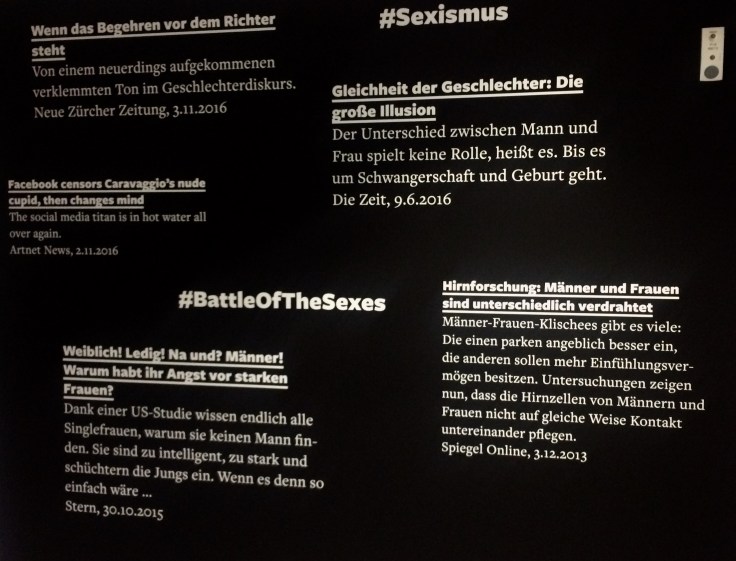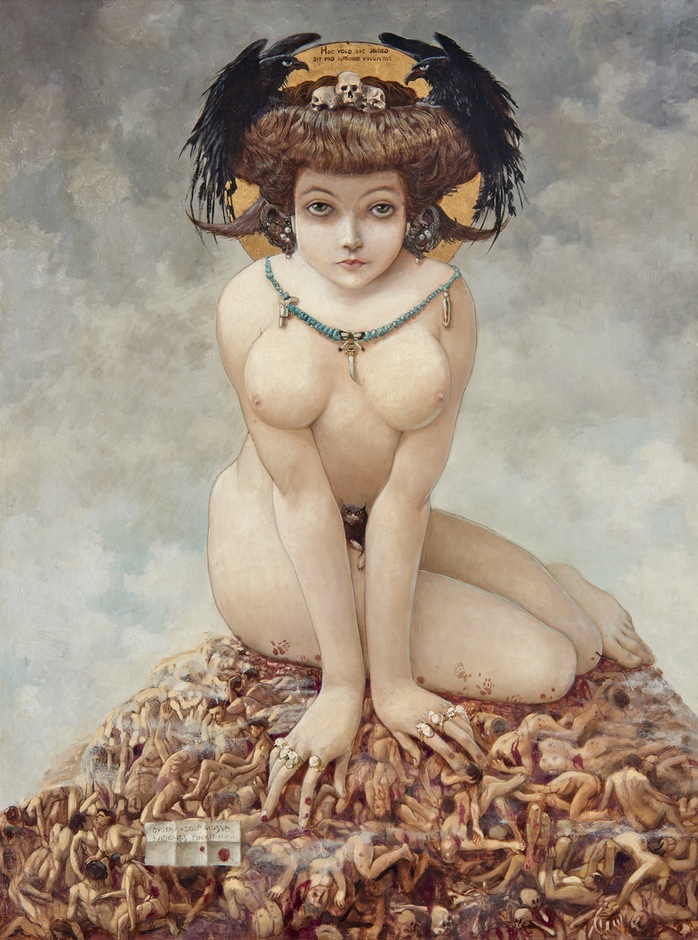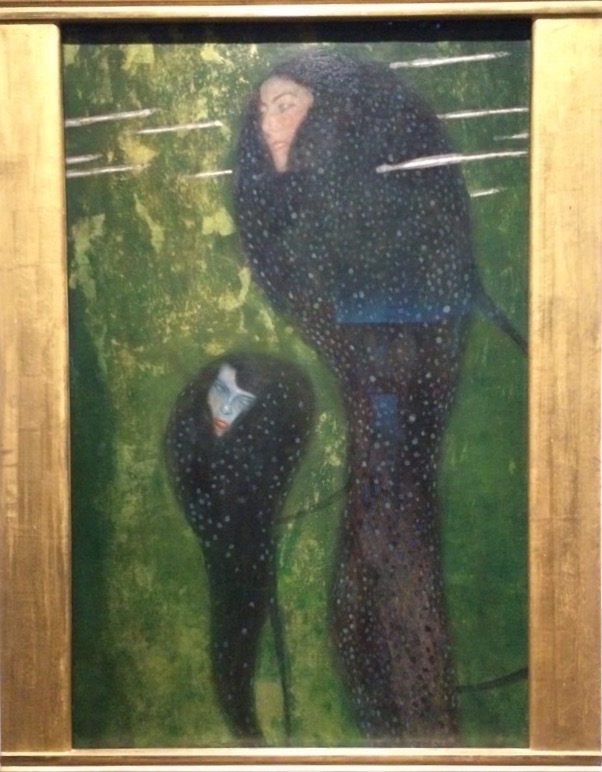The best exhibiton I have ever been to! Contemporary, captivating & courageous, Battle Of The Sexes takes on society’s attitudes towards women from the nineteenth century to the end of World War Two. Threatening, seductive and second class citizens are all opinions of women that have lead to the battle of the sexes that we all live in today.
On entrance to the exhibition, I was surrounded by hundreds of quotes screaming both sexism and gender stereotypes directly at me.
This ridiculous quote about Kendall Jenner, which appeared in a newspaper last summer, literally made me laugh out loud. I’ll translate it for you:
Going braless is trendy: Freedom for Breasts!
Kendall Jenner isn’t the only one. This summer, a lot of women prefer to leave the house without a bra on. Why? Or even better, why not?
Stern, 15.8.2016
Seriously, who the hell cares?

Bore off John…

Check out the hashtags below, and for those of you who can speak German have a read of the quotes. I couldn’t quite manage to take the photo without someone getting in the way – it was rammed!


Threateningly Feminine
Right up until the mid 19th Century marriage and family were the assigned roles of women. But for the first time in recorded history, the tables were about to be turned.
The women’s movement began. It shook up society as women began to play a ‘significant’ role. They wanted their own voice, they wanted the right to vote- was this really too much to ask?
Such an extraordinary request left the male ego feeling unsettled. Women came to be viewed as a threat – for the first time.
Gustav Adolf Mossa’s painting of the Femme Fatal (fatal woman in French) demonstrates this perfectly. Sat on top of a mountain of weak and wounded men, the woman is a powerful, seductive threat. Look closely and you’ll see that she’s not just physically crushing the men, but the crows, the skulls, and even the weapons on her necklace hightlight how intimidating she is.

Unfortunately, this negative perception of women was also expressed through mythological and religious art over the next 100 years.
Evil Eve
Take a look at these two paintings of Adam and Eve in the garden of Eden. One by a male artist and the other by a female artist. Susan Valadon had to cover Adam’s genitals for the Salon des Indépendants exhibtion in Paris in 1920. If not, they would have refused to display her work as the exposure of men’s genitals was indecent, but hey – not to worry about Eve’s!
On the left, Franz von Stuck portrays Eve as an evil seducer, removing all biblical context. Rather than taking the apple that Eve offers him whilst the serpent secures itself around her, Adam reaches for Eve’s body, dismissing the fruit altogether.
On the right, Suzanne Valadon’s naked self-portrait representing Eve contrasts to that of Stuck’s. Eve shares the responsibilty of the fall of man with Adam (painted as her partner) and Valadon only added the leaves because she was requested to do so.
Franz von Stuck
Throughout the 1890s, Stuck extracts biblical and mythical figures from their context and portrays them through his own eyes. As women slowly gained power in society, Stuck showed this to only be possible through their sexuality and seduction.
Do you remember learning about Medusa at school? A once beautiful woman who was punished with snakes for hair and eyes that would turn anyone who looked directly into them to stone. Stuck used Greek Mythology as another way to portray his feelings towards women, his painting of Medusa came to symbolise the male fear of castration. Also, I hardly think it’s a coinsidence that before her punishment Medusa was an extremely attractive woman, who later came to be seen as an evil threat and was punished for being proud of herself.

I was surprised to see Stuck’s powerful sculpture of a woman at war, contrasting his views on society and empowering women. However, if you look to the right of the photo, you’ll see the small, weak male victim. I don’t know why I got my hopes up, Stuck clearly wasn’t a fan of the opposite sex!

The Battle Continues…
The Women’s Movement was well underway in the 1900s with more states in America winning the women’s right to vote. Although gender roles remained firm, political and sexual freedom was on the rise. This however, increased the fear of women amongst men and scientific research was performed in Physiological Imbecility of Women (Paul Julius Möbius, 1900) and Sex and Characterister (Otto Weiniger, 1903) to prove woman’s inferior nature. Let’s see what Otto Weininger had to say…

…really?
Below is Gustav Klimt’s painting from the early 1900s. This creative work of art potrays women as sea spirits who enter men with their charm and drag them to the bottom of the sea. The sperm like shape of the evil shimmering silver fish is a feature expressing the forbidden female sexuality. In the 20th Century water was often used to represent the giving of life as well as being used as a destrutive force, and of course, was only associated with women.

As If!?
Although things seemed to be on the up for women, it was only in 1976 that men in Germany were no longer legally allowed to cancel their wives’ work contracts! The wives belonged at home, the husbands made the rules and sexual escapades were only acceptable for men. Believe it or not, this only became legal in the first place in the year 1900.
Sex Sells
After a long time away from home during the war, men were returning to the household often mentally traumatised and physically disabled. Women had been balancing their respective duties in the home whilst fulfilling their husbands’ social roles simultaneously. Pressures were high and as poverty and famine forced the countrypeople to the city, unemployment increased forcing women into prostitution.
As illustrated in the image below, prostitution was of course no luxury form of employment.

Josef Scharl uses this painting of a naked prostitute; head shaved and hands behind her back, to show the misuse of physical power on prostitutes. The painting resembles a mug shot, as the woman’s battered face and bruised neck are openly displayed. Punishment?
The rise of prostitution meant the spread of STIs. In the 20th Century all prostitutes were forced to undergo STI treatment- not the men, just the women. Who would have thought that the number of men carrying STIs was actually higher than that carried by women?
Finally A Bit More Freedom
Society was warming to the idea that… no, that is probably too strong a phrase. Society was having to accept that women can be associated with sexuality. In 1929/ 1930, Karl Hubbuch rebelled against the traditional dos and don’ts by demonstrating freedom of sexuality in his “Marianne Before A Mirror” painting. Whilst the woman appears to experience pleasure, her reflection appears to be flirting with someone. Hubbuch’s use of the mirror image exaggerates and highlights the woman’s physicality.

Frida Kahlo
From 1930, the surrealist movement brought male and female artists to Europe from all over the world. Frida Kahlo was one of them and if you haven’t already heard, she was a politically active, self-taught, portrait artist from Mexico. Although Kahlo suffered with polio from age 6 and was later in a bus crash that left her in pain for the rest of her life, she displayed her opinions on the female body and sexual desire through her expressive art. Kahlo’s substantial influence on the surrealist movement contributed to her becoming one of Mexico’s greatest artists.
Kahlo is well-known for her striking monobrow, which to reflects the shape of a hummingbird, representing luck in love in Mexican culture. Kahlo however, used her monobrow to highlight her disappointment towards her marriage.

In the above self-portrait Kahlo displays two sides to her womanhood: Her free and wild hair on the left, reflecting her personality and natural flair, in contrast to the neat and tidy plait on the right, showing her ability to be civilised and reserved. Kahlo was a woman of many traits. Through her art, she encouraged others to recognise their own characteristics and express their right to do so.
And Where Does All This Leave Us?
Well honestly, who knows? But society is still changing and although the battle is far from over, it is only you, one of the sexes, who can help to bring us to equality.
More On The Exhibition
Städel Museum
Frankfurt am Main
Running until 19.03.2017




Absolutely brilliant!! Insightful and love the use of images to illustrate the narrative! Xx
LikeLiked by 1 person
Thanks – the exhibition was so informative!
LikeLike
Wow, great detail Alisa! Looks like such an interesting exhibition and a very fitting post for International Woman’s Day. Love it!
LikeLiked by 1 person
Thanks!
LikeLike
Another really interesting article Alisa! Brilliant stuff.
LikeLiked by 1 person
Thanks!
LikeLike